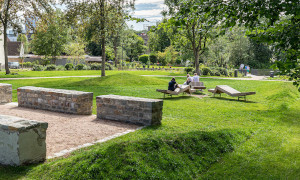The bdla's latest event format also met with lively interest: Over 160 participants came to the Designer Days on 28 and 29 September 2018 in the Taut Saal at the German Architecture Centre in Berlin.
Much to the delight of moderator and bdla vice president Stephan Lenzen, who already announced a larger hall for next year. He had put together a wide range of topics for the two days, concentrating on concrete, natural stone and design techniques, always interspersed with reports on works.
Friday started with Markus Brunner from InformationsZentrum Beton GmbH in Berlin. The civil engineer advises on all questions relating to concrete, from technology to tendering. For the participants, he gave an insight into the world of photoconcrete, photogravure and betography - methods with which interesting effects can also be achieved on vertical concrete surfaces in outdoor areas.
Kathrin Aste from the Austrian architecture firm LAAC then led the way away from the two-dimensional, presenting, among other things, the Landhausplatz in Innsbruck. "The square is a body," she emphasized and told of the adventure of building a concrete sculpture as an accessible square. The challenging project was realized with in-situ concrete. For a long time, the planners fiddled with the composition of the concrete, the shape and structure of the individual cubatures and their processing.
KEHRBAUMARCHITEKTEN AG from Munich proceeded in a similar way, approaching the best possible result, with the stamped concrete walls of the forest cemetery in Landsberg am Lech. The decisive factor, emphasized office owner Johannes Eck, is to have a company that is willing to try things out: to experiment with the pattern, grain and colouring of the walls and to try out how firmly they have to be tamped until everything fits.
The range of topics on concrete and natural stone was rounded off by Detlef Richter from Steinzeit Natursteine GmbH in Bonn, the sculptor and stonemason Michael Senn from Munich and Viktor Mechtcherine from the Institute for Building Materials at the Technical University of Dresden. Richter invited the audience on a journey around the globe to rather unknown quarries and gave an overview of different natural stones, while Senn gave an insight into the numerous possibilities of surface treatment. Finally, Mechtcherine presented his research on 3D printing processes with concrete.
Two landscape architects gave inspiring suggestions on how to deal with materials: Maren Brakebusch, office manager of Vogt Landscape Architects, Zurich, and Prof. Jenny B. Osuldsen, partner in the architectural firm Snøhetta, Oslo. "The use of material is a question of attitude," Brakebusch explained. Accordingly, the firm's projects are characterised by a precise analysis of the surrounding landscape and its geomorphological processes - which is then reflected in the materials used. For Snøhetta, too, the choice and processing of materials play an essential role. No less important for a successful design, as became clear in Osuldsen's lively lecture, is a good office atmosphere. "It's all about people," she emphasized. It's always about people, those who use the public spaces and buildings, and in the office, those who plan them.
Saturday was then all about digital tools for design. Matthias Funk, partner of scape Landschaftsarchitekten from Düsseldorf and head of the BIM working group in the bdla, reported on his experiences with the tool, which is still unfamiliar to landscape architects. He said that scape had also been unexpectedly confronted with the topic during a project, but would now consciously apply for BIM tasks in order to penetrate further into the topic. After all, knowing what the programs can do helps get a handle on complex projects. He emphasized, "Everything is for the sake of design." And accordingly, BIM is nothing more, but also nothing less than a tool that should be harnessed.
The same applies to technologies for visualization, which Olaf Schroth, professor at the Weihenstephan-Triesdorf University of Applied Sciences, presented. Augmented reality, for example, can help to better communicate designs in the context of public participation. Another digital tool was presented by Benedikt Kowalewski from the Chair of Prof. Girot at ETH Zurich: point clouds. Here, the project area is measured with a laser scanner and integrated into existing data. The resulting point model then serves as a starting point for designs. A tool with a future, also in Christophe Girot's eyes, who concluded the conference with an impassioned plea to keep in mind what it means to design landscape and to discuss what role landscape architects can and should play in the design of cities and their surroundings.
Excursions to the Park am Gleisdreieck, the Park am Nordbahnhof and the Berlin Wall Memorial rounded off the two days of events, which were made possible with the support of the Lorenz von Ehren Nursery and Runge GmbH.
- Latitude: 0
- Longitude: 0


